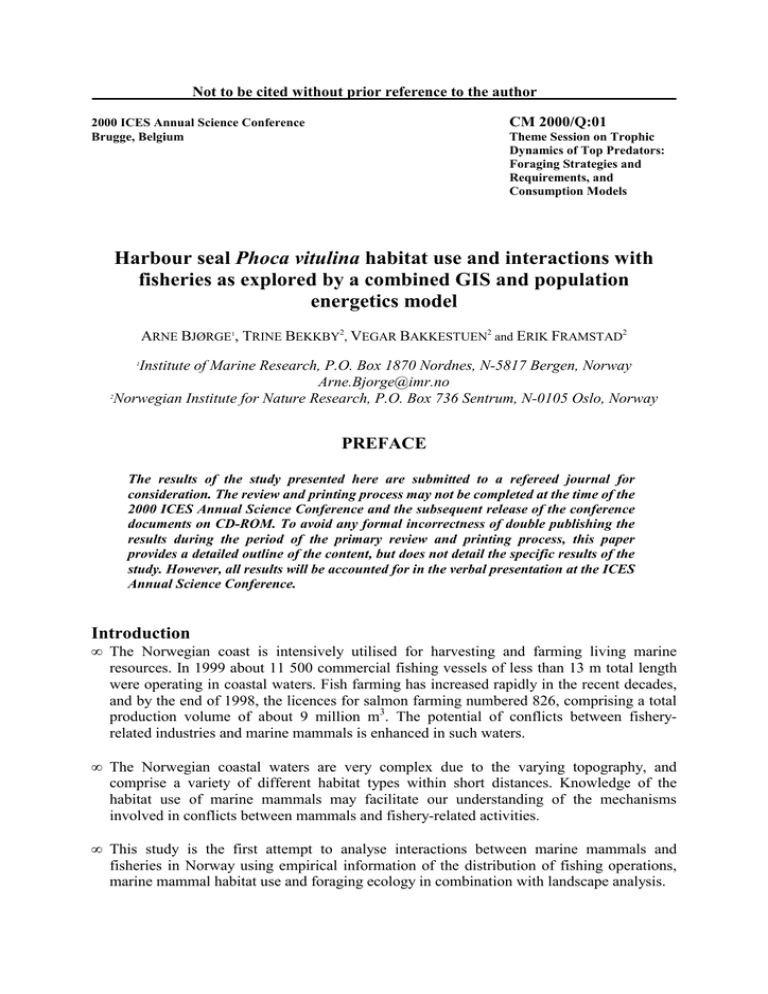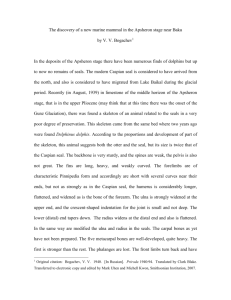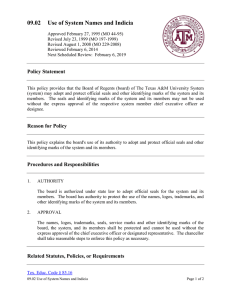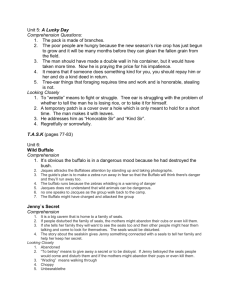_____________Not to be cited without prior reference to the author ... CM 2000/Q:01
advertisement

_____________Not to be cited without prior reference to the author ______ ________ CM 2000/Q:01 2000 ICES Annual Science Conference Brugge, Belgium Theme Session on Trophic Dynamics of Top Predators: Foraging Strategies and Requirements, and Consumption Models Harbour seal Phoca vitulina habitat use and interactions with fisheries as explored by a combined GIS and population energetics model ARNE BJØRGE1, TRINE BEKKBY2, VEGAR BAKKESTUEN2 and ERIK FRAMSTAD2 Institute of Marine Research, P.O. Box 1870 Nordnes, N-5817 Bergen, Norway Arne.Bjorge@imr.no 2 Norwegian Institute for Nature Research, P.O. Box 736 Sentrum, N-0105 Oslo, Norway 1 PREFACE The results of the study presented here are submitted to a refereed journal for consideration. The review and printing process may not be completed at the time of the 2000 ICES Annual Science Conference and the subsequent release of the conference documents on CD-ROM. To avoid any formal incorrectness of double publishing the results during the period of the primary review and printing process, this paper provides a detailed outline of the content, but does not detail the specific results of the study. However, all results will be accounted for in the verbal presentation at the ICES Annual Science Conference. Introduction • The Norwegian coast is intensively utilised for harvesting and farming living marine resources. In 1999 about 11 500 commercial fishing vessels of less than 13 m total length were operating in coastal waters. Fish farming has increased rapidly in the recent decades, and by the end of 1998, the licences for salmon farming numbered 826, comprising a total production volume of about 9 million m3. The potential of conflicts between fisheryrelated industries and marine mammals is enhanced in such waters. • The Norwegian coastal waters are very complex due to the varying topography, and comprise a variety of different habitat types within short distances. Knowledge of the habitat use of marine mammals may facilitate our understanding of the mechanisms involved in conflicts between mammals and fishery-related activities. • This study is the first attempt to analyse interactions between marine mammals and fisheries in Norway using empirical information of the distribution of fishing operations, marine mammal habitat use and foraging ecology in combination with landscape analysis. Methods • A 1680 km2 coastal archipelago in Norway (62ºN 6ºE) housing a population of approximately 750 harbour seals was modelled in a geographical information system (GIS). Proportions of different habitat types available to harbour seals for haul-out and foraging were estimated. • Information on fishing activities in the area was provided by local fishers and by the Norwegian Fishermen’s Association. The distribution of fishing operations was included in the GIS model. • The diet of seals in the area was established from otoliths in faecal samples collected at haul-out sites, and the energy densities of prey species were taken from literature. • Empirical data on movements and foraging activities of harbour seals were available from VHF radio-tracked seals. We developed a procedure to extrapolate from individual behavioural data to a population level foraging distribution of the 750 harbour seals inhabiting the model area. • A population energetics simulation model based on activity, body size and composition, simulated the harbour seal energy requirements from 20 June to 31 August. Activity data from radio-tracked seals were used to parameterise the energetics model, and the population level distribution of foraging seals was used to combine the GIS and the energetics models. Results and Discussion • The seals were foraging in 100-200 m deep areas, and in tidal currents and eddies created at shallow rocks covered by kelp, Laminaria hyperborea. The two most highly selected areas were deep basins with soft substrate and the kelp areas. • Two of the most frequently occurring species in the seal diet were found to be associated to these habitats, Norway pout Trisopterus esmarkii in the deep basins, and young saithe Pollachius virens in tidal currents of the kelp zone. • The energy density of the diet was determined, and the total consumption by the seal population was estimated. Consumption in each foraging habitat type was calculated. The daily consumption of the population of 750 harbour seals averaged about 3 tons during the simulation period. • The co-occurrence of fishing operations and foraging seals was analysed. Trawling for shrimps Pandalus borealis co-occurred with foraging seals, but they targeted different species. Fisheries for several Gadidae species deploying Danish seine and bottom-set gillnets, co-occurred with foraging seals, and they partly targeted the same fish species. The daily removal of fish by seals at the actual fishing grounds was estimated. • The largest potential for interaction between fisheries and harbour seals was associated to a bottom-set gillnet fishery at 100-200 m depth just off the coast. Seals were foraging on fish species targeted by the fishery, and entanglement of seals in this type fishery was assumed to have an effect on seal population growth rate in the area. 2 • To explore the effects of inaccuracies in our assumptions generated from empirical data, we changed the diet composition, sea temperature, activity levels and blubber thickness; one parameter at the time, keeping all others constant in the simulations. A change in energy density of the food by increasing the herring part of the diet from 10% to 20% by weight, resulted in an estimated decrease of daily per capita food consumption of 0.3kg and 0.35kg for females and males, respectively. A reduction of the sea temperature with 1ºC, an increase in blubber thickness from 0.02 m to 0.03 m, and 10% change in activity levels, all had less effect on food consumption than the change in diet composition. 3





